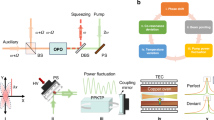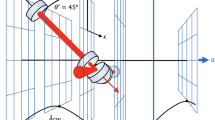Abstract
Around the globe several observatories are seeking the first direct detection of gravitational waves (GWs). These waves are predicted by Einstein’s general theory of relativity1 and are generated, for example, by black-hole binary systems2. Present GW detectors are Michelson-type kilometre-scale laser interferometers measuring the distance changes between mirrors suspended in vacuum. The sensitivity of these detectors at frequencies above several hundred hertz is limited by the vacuum (zero-point) fluctuations of the electromagnetic field. A quantum technology—the injection of squeezed light3—offers a solution to this problem. Here we demonstrate the squeezed-light enhancement of GEO 600, which will be the GW observatory operated by the LIGO Scientific Collaboration in its search for GWs for the next 3–4 years. GEO 600 now operates with its best ever sensitivity, which proves the usefulness of quantum entanglement and the qualification of squeezed light as a key technology for future GW astronomy4.
This is a preview of subscription content, access via your institution
Access options
Subscribe to this journal
Receive 12 print issues and online access
$259.00 per year
only $21.58 per issue
Buy this article
- Purchase on SpringerLink
- Instant access to full article PDF
Prices may be subject to local taxes which are calculated during checkout



Similar content being viewed by others
References
Einstein, A. Die Grundlage der allgemeinen Relativitätstheorie. Ann. Phys. 49, 769–822 (1916).
Sathyaprakash, B. S. & Schutz, B. F. Physics, astrophysics and cosmology with gravitational waves. Living Rev. Relativ. 12 (2009) http://www.livingreviews.org/lrr-2009-2.
Caves, C. M. Quantum-mechanical noise in an interferometer. Phys. Rev. D 23, 1693–1708 (1981).
Schnabel, R., Mavalvala, N., McClelland, D. E. & Lam, P. K. Quantum metrology for gravitational wave astronomy. Nature Commun. 1, 121 (2010).
Weiss, R. in Quarterly Progress Report Vol. 105, 54–76 (Research Laboratory of Electronics, MIT, 1972).
Abbott, B. P. et al. LIGO: The laser interferometer gravitational-wave observatory. Rep. Prog. Phys. 72, 076901 (2009).
Acernese, F. et al. Status of Virgo. Class. Quantum Grav. 25, 114045 (2008).
Willke, B. et al. The GEO 600 gravitational wave detector. Class. Quantum Grav. 19, 1377–1387 (2002).
Grote, H. et al. The GEO 600 status. Class. Quantum Grav. 27, 084003 (2010).
Arai, K. et al. Status of Japanese gravitational wave detectors. Class. Quantum Grav. 26, 204020 (2009).
Barriga, P. et al. AIGO: A southern hemisphere detector for the worldwide array of ground-based interferometric gravitational wave detectors. Class. Quantum Grav. 27, 084005 (2010).
Punturo, M. et al. The third generation of gravitational wave observatories and their science reach. Class. Quantum Grav. 27, 084007 (2010).
The LIGO Scientific Collaboration & The Virgo Collaboration, An upper limit on the stochastic gravitational-wave background of cosmological origin. Nature 460, 990–994 (2009).
Walls, D. F. Squeezed states of light. Nature 306, 141–146 (1983).
Slusher, R. E., Hollberg, L. W., Yurke, B., Mertz, J. C. & Valley, J. F. Observation of squeezed states generated by four-wave mixing in an optical cavity. Phys. Rev. Lett. 55, 2409–2412 (1985).
Eberle, T. et al. Quantum enhancement of the zero-area Sagnac interferometer topology for gravitational wave detection. Phys. Rev. Lett. 104, 251102 (2010).
McKenzie, K. et al. Squeezing in the audio gravitational-wave detection band. Phys. Rev. Lett. 93, 161105 (2004).
Vahlbruch, H., Chelkowski, S., Danzmann, K. & Schnabel, R. Quantum engineering of squeezed states for quantum communication and metrology. New J. Phys. 9, 371 (2007).
Vahlbruch, H. et al. Coherent control of vacuum squeezing in the gravitational-wave detection band. Phys. Rev. Lett. 97, 011101 (2006).
McKenzie, K., Shaddock, D. A., McClelland, D. E., Buchler, B. C. & Lam, P. K. Experimental demonstration of a squeezing-enhanced power-recycled Michelson interferometer for gravitational wave detection. Phys. Rev. Lett. 88, 231102 (2002).
Goda, K. et al. A quantum-enhanced prototype gravitational-wave detector. Nature Phys. 4, 472–476 (2008).
Yonezawa, H., Aoki, T. & Furusawa, A. Demonstration of a quantum teleportation network for continuous variables. Nature 431, 430–433 (2004).
Jensen, K. et al. Quantum memory for entangled continuous-variable states. Nature Phys. 7, 13–16 (2010).
Grote, H. et al. The GEO 600 status. Class. Quantum Grav. 25, 114030 (2008).
Lück, H. et al. The upgrade of GEO 600. J. Phys. Conf. Ser. 228, 012012 (2010).
Degallaix, J. et al. Commissioning of the tuned DC readout at GEO 600. J. Phys. Conf. Ser. 228, 012013 (2010).
Hild, S. et al. DC-readout of a signal-recycled gravitational wave detector. Class. Quantum Grav. 26, 055012 (2009).
Vahlbruch, H. et al. The GEO 600 squeezed light source. Class. Quantum Grav. 27, 084027 (2010).
Caves, C. M. Quantum-mechanical radiation-pressure fluctuations in an interferometer. Phys. Rev. Lett. 45, 75–79 (1980).
Franzen, A., Hage, B., DiGuglielmo, J., Fiurášek, J. & Schnabel, R. Experimental demonstration of continuous variable purification of squeezed states. Phys. Rev. Lett. 97, 150505 (2006).
Acknowledgements
The authors gratefully acknowledge the support of the United States National Science Foundation for the construction and operation of the LIGO Laboratory and the Science and Technology Facilities Council of the United Kingdom, the Max Planck Society, the Deutsche Forschungsgemeinschaft, the cluster of excellence QUEST (Centre for Quantum Engineering and Space-Time Research), the BMBF, the Volkswagen Foundation, and the State of Niedersachsen/Germany for support of the construction and operation of the GEO 600 detector. The authors also gratefully acknowledge the support of the research by these agencies and by the International Max Planck Research School (IMPRS), the SFB TR7, the FP7 project Q-ESSENCE, the Australian Research Council, the Council of Scientific and Industrial Research of India, the Istituto Nazionale di Fisica Nucleare of Italy, the Spanish Ministerio de Educación y Ciencia, the Conselleria d’Economia, Hisenda i Innovació of the Govern de les Illes Balears, the Royal Society, the Scottish Funding Council, the Scottish Universities Physics Alliance, The National Aeronautics and Space Administration, the Carnegie Trust, the Leverhulme Trust, the David and Lucile Packard Foundation, the Research Corporation, and the A. P. Sloan Foundation.
Author information
Authors and Affiliations
Consortia
Contributions
A list of authors and their affiliations appear in the Supplementary Information The activities of the LIGO Scientific Collaboration (LSC) cover modelling astrophysical sources of gravitational waves, setting sensitivity requirements of observatories, designing, building and running observatories and researching new techniques to increase the sensitivity of these observatories, and performing searches for astrophysical signals contained in the data. The principal investigators of the advancement reported here are H.G. and R.S., being responsible for GEO 600 and for the squeezed-light laser during the past 3 years, in which this experiment was prepared and conducted, respectively. In this period a great number of the LSC members contributed directly to the success of this project. H.V. and H.G. supervised the integration of the squeezed-light laser into GEO 600. Together with A.K., they took and analysed the data shown. The initial manuscript was written by a team involving those mentioned above together with R.S. The manuscript went into a two-stage LSC-wide review process, which was organized and led by R.F., T.R.C., M.H., and D.Sigg. All authors approved the final version of the manuscript.
Corresponding author
Ethics declarations
Competing interests
The author declare no competing financial interests.
Supplementary information
Supplementary Information
Supplementary Information (PDF 255 kb)
Rights and permissions
About this article
Cite this article
The LIGO Scientific Collaboration. A gravitational wave observatory operating beyond the quantum shot-noise limit. Nature Phys 7, 962–965 (2011). https://doi.org/10.1038/nphys2083
Received:
Accepted:
Published:
Issue date:
DOI: https://doi.org/10.1038/nphys2083
This article is cited by
-
Quantum force sensing by digital twinning of atomic Bose-Einstein condensates
Communications Physics (2024)
-
Ultrastrong to nearly deep-strong magnon-magnon coupling with a high degree of freedom in synthetic antiferromagnets
Nature Communications (2024)
-
Amplification of squeezing and anti-bunching in the output beams from a degenerate parametric amplifier: linear and nonlinear coherent state approaches
Quantum Information Processing (2024)
-
Acoustic frequency atomic spin oscillator in the quantum regime
Nature Communications (2023)
-
On the equivalence between squeezing and entanglement potential for two-mode Gaussian states
Scientific Reports (2023)



